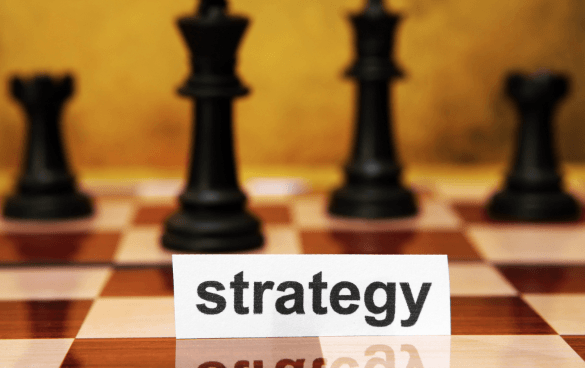-
 Published: Apr 13, 2023
Published: Apr 13, 2023
-
 7 min. read
7 min. read
-
 Maria Carpena
Maria Carpena Emerging Trends & Research Writer
Emerging Trends & Research Writer
- Maria is an experienced marketing professional in both B2C and B2B spaces. She’s earned certifications in inbound marketing, content marketing, Google Analytics, and PR. Her favorite topics include digital marketing, social media, and AI. When she’s not immersed in digital marketing and writing, she’s running, swimming, biking, or playing with her dogs.
Product strategy definition: Product strategy is a plan that details how you’ll develop a product that addresses your customer’s needs and how you’ll market the product. It also explains how the product can help you reach your business goals.
Johan’s baked goods have always been a hit among his customers. Every January, though, his bakery business faces a dip in sales. After chatting with regulars, he discovers that most of his customers resolve to eat fewer sweets at the start of the year after the festive holidays.
Because of this finding, he wants to develop seasonal carb-free and low-calorie offerings at the beginning of each year. Johan needs a solid product strategy to get started.
If you’re like Johan and you need help with developing a product strategy, this blog post is for you. We will discuss the following:
- What is product strategy?
- Why is product strategy important?
- 3 elements of a product strategy framework
- 5 types of product strategy
- How to create a product strategy
While you’re here, subscribe to our free newsletter to join a community of 200,000 marketers who get their digital marketing tips delivered straight to their inbox.
Don’t miss our Marketing Manager Insider emails!
Join 200K smart marketers for the hottest marketing news and insights in your inbox.
Inline Subscription Form
“*” indicates required fields


What is product strategy?
Product strategy is a business’s plan that details how to develop a product that can address your customer’s needs and how you’ll market the product. It also explains how the product can help you reach your business goals.
Product strategies are a guide for a product’s ideation, development, and launch, and they have helped numerous companies succeed. A robust product strategy helps your business stay on track to progress and carry out a product roadmap.
Why is product strategy important?
A product strategy framework is crucial to your product’s success, guiding you to create and launch your offering to your target market. It provides the following benefits:
- Identifying your product’s niche
- Providing a clear direction to your teams
- Setting a foundation for your product roadmap
Let’s discuss each benefit:
Identifying your product’s niche
Your product isn’t for everyone. In our earlier example, Johan’s low-calorie products aren’t meant for all his patrons. The products, however, are meant for a particular customer segment.
A product strategy can help Johan and businesses like yours clearly define your product’s niche. By clearly understanding your product’s niche, your product development team can make decisions with your target audience in mind.
Providing a clear direction to your teams
A product strategy aligns different teams within your organization. Equipped with knowledge about your product niche and strategy, your sales team knows how to discuss your product’s unique selling propositions (USPs) and value with your prospects.
Your marketing team can craft a plan and launch campaigns that reach the right audience with marketing messages that resonate with them.
How does your product work, and how does it address your customer’s pain points? When your after-sales team knows the answers to these questions, they can better answer your customer’s questions. In addition, they can anticipate questions and prepare beforehand.
Setting a foundation for your product roadmap
Your product strategy clearly shows what your business wants to accomplish with your product. It also defines the roles of the different teams within your organization and the different product development phases.
A product strategy sets a solid foundation for your product roadmap. It is then easier to create a product roadmap that details how you’ll execute your plan.
3 elements of a product strategy framework
Different businesses will have their own product strategy frameworks. Each product strategy framework, however, will always have these elements:
Let’s discuss each one:
1. Market vision
What is the business opportunity that your product is grabbing? How will your product serve your customers?
These are some of the questions that your market vision must tackle. In addition, your market vision defines your target customers and details how you position your product in the market.
2. Goals
What do you want to accomplish with your product? Setting goals gives the different teams in your business a timeline for product development, launch, and other initiatives under your product strategy.
Make specific, measurable, attainable, relevant, and time-bound (SMART) goals to quickly determine whether you’ve attained your objectives. Here are a few examples of SMART goals for Johan’s low-calorie pastries:
- Generate sales of 3,000 low-calorie pastries in the first month of launch
- Increase sales of low-calorie pastries by 3% month over month
3. Initiatives
Initiatives are your business’s area of focus and investment based on the goals you’ve outlined in your strategy. They typically require different teams within a company to collaborate to achieve success.
For example, let’s say you own a ballet studio, and one of your goals is to increase your business’s customer retention by 10% by the end of the year.
Your initiatives involve your marketing team understanding your customers better to provide offerings that interest them. In addition, your sales team can also take advantage of upsell opportunities. If they sign up for spring and fall classes, they’ll get more value with their money.
5 types of product strategy
Different businesses require different strategies. After all, each one has a set of unique company goals. Here are different types of product strategies that businesses can explore:
- Cost: Is there an opportunity for an offering that costs less than existing products? Companies who create daily necessities, like toilet paper, can use this strategy. These products are built cost-effectively to compete against existing products with the advantage of a lower price.
- Service: This product strategy provides excellent customer service besides having a feature set that addresses customer needs. By providing unrivaled after-sales support, you foster brand loyalty among existing customers.
- Differentiation: Does your product or service have a unique feature not seen in current solutions? This product strategy capitalizes on special features as they attract customers. Mobile phone makers have been using this product strategy to introduce new features with each launch.
- Focus: If you’re introducing a product that caters to a specific buyer persona, you’re employing this product strategy type. Focusing your efforts on a particular set of customers helps you create personalized offerings that cultivate brand loyalty.
- Quality: Luxury brands employ this type of product strategy, as their customers care more about the quality of the product than the price tag. This product strategy uses high-quality materials or ingredients to satisfy its customers.
How to create a product strategy (+ questions to ask)
Using the elements of our product strategy framework earlier, you can create your business’s product strategy through these steps:
Let’s go through each one:
1. Have a market vision
Identify the business opportunity that you’re targeting with your product. Make sure you answer the following questions:
- Which of your competitors is dominating the market?
- What are the challenges that your business is facing?
- What are your business’s strengths?
- Who is your target customer?
- What does the market look like?
- How will you promote your product?
2. Set goals for your product
SMART goals can help you track your success. You can also use these guide questions:
- Is the market volatile?
- What metrics should you track regularly?
- What must your business achieve with the product?
- How involved are the different teams in each goal?
3. Plan your initiatives
Your initiatives require different teams within your business to collaborate to achieve success, so you need to align with all your stakeholders. You need to ask yourself these questions:
- What are your priorities?
- What are the buyer personas that you’re targeting?
Create a winning product strategy with WebFX
An effective product strategy is crucial for any business. If you need help with crafting a product strategy, WebFX can help.
WebFX is an award-winning full-service digital marketing agency with experience in over 200+ industries. We’ve helped over 1,450+ clients craft strategies that drive results and grow their bottom line.
Contact us online or call us at 888-601-5359 to speak with a strategist about creating a winning product strategy and digital marketing services that deliver revenue!
-
 Maria is an experienced marketing professional in both B2C and B2B spaces. She’s earned certifications in inbound marketing, content marketing, Google Analytics, and PR. Her favorite topics include digital marketing, social media, and AI. When she’s not immersed in digital marketing and writing, she’s running, swimming, biking, or playing with her dogs.
Maria is an experienced marketing professional in both B2C and B2B spaces. She’s earned certifications in inbound marketing, content marketing, Google Analytics, and PR. Her favorite topics include digital marketing, social media, and AI. When she’s not immersed in digital marketing and writing, she’s running, swimming, biking, or playing with her dogs. -

WebFX is a full-service marketing agency with 1,100+ client reviews and a 4.9-star rating on Clutch! Find out how our expert team and revenue-accelerating tech can drive results for you! Learn more
Try our free Marketing Calculator
Craft a tailored online marketing strategy! Utilize our free Internet marketing calculator for a custom plan based on your location, reach, timeframe, and budget.
Plan Your Marketing Budget
Table of Contents
- What is product strategy?
- Why is product strategy important?
- Identifying your product’s niche
- Providing a clear direction to your teams
- Setting a foundation for your product roadmap
- 3 elements of a product strategy framework
- 1. Market vision
- 2. Goals
- 3. Initiatives
- 5 types of product strategy
- How to create a product strategy (+ questions to ask)
- 1. Have a market vision
- 2. Set goals for your product
- 3. Plan your initiatives
- Create a winning product strategy with WebFX

Proven Marketing Strategies

Proven Marketing Strategies
Try our free Marketing Calculator
Craft a tailored online marketing strategy! Utilize our free Internet marketing calculator for a custom plan based on your location, reach, timeframe, and budget.
Plan Your Marketing Budget
What to read next





